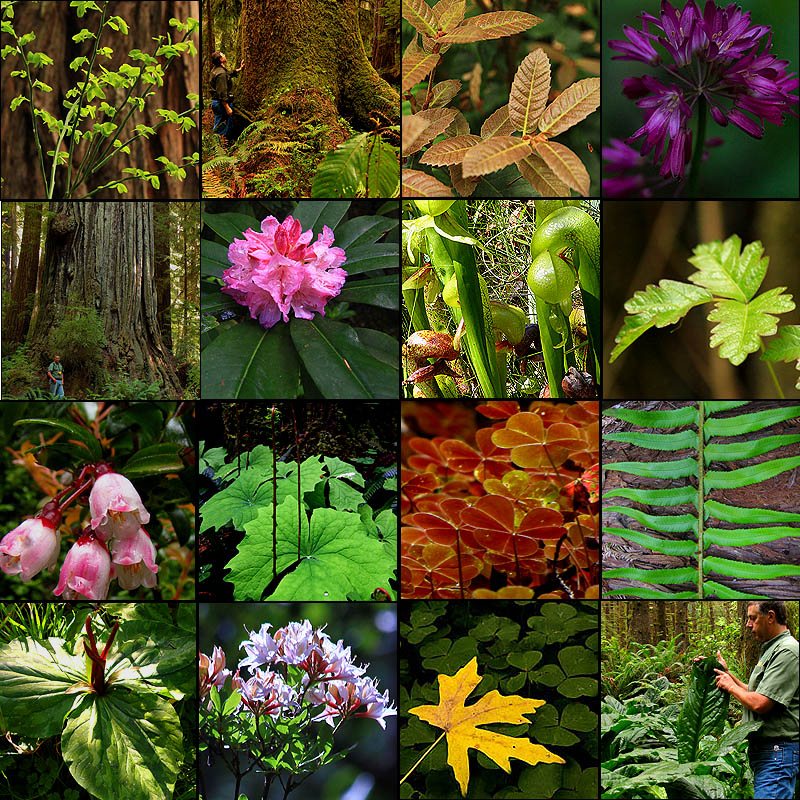
Redwood Forest Plant Identification Quiz - Answers
How many did you recognize? Find the answers below.
Continued from: Coast Redwoods

advertisement
by Mario Vaden
Click this link to go back to the quiz page
1. Red Huckleberry. Very small leaves with green stems. The leaves or nodes alternate right, left, right left, rather than opposite each other on the stem.
2. Sitka spruce. It is not most likely to find a Douglas fir this size. Coast redwood should not have this much moss on it. And Sitka spruce, as you see, at this large size, lacks the bigger furrows in the bark that Douglas fir would have. It is not likely to see western hemlock this fat, but more likely to find spruce this big: as you see.
3. Tanoak. A broadleaf evergreen with toothed or serrated looking leaf margins, pointed at the end, and distinct pattern across top surface. Also alternating leaves.
4. Clintonia. Small plant with leaves under 2 feet high. Prior to blue berries, this is what the flower looks like.
5. Coast redwood. No other species with have a trunk this big in the north rewood parks. Had I shown foliage or cones, here's something else to go on ... Redwood needles are pointed and the cones barely 3/4 of an inch. Western hemlock cones are tiny, but the needles are blunt on the ends. Sitka spruce have medium cones that are smooth and the needles can feel pointy. Douglas fir needles are blunt ended, and the cones are a few inches long, with little scales protruding that look imaginitively like the tail and legs of a mouse, but paper thin. Port Orford cedar or Western redcedar foliage does not look like distinct needles attached in rows.
Scroll below this image for the rest of the answers ...
Photo: 16 different species of plants in the north coast redwoods.

6. Rhododendron. Shrub that can grow to 10 or 20 feet or more. These are the flowers near May and June: pink and dark pink or red buds prior to opening. Big leathery broadleaf evergreen leaves.
7. Darlingtonia / Cobra Lily. One place to view this unique plant is near mile marker 17 or 18 east of Crescent City, off Highway 199. Cobra Lily can also be seen at the edge of the road minutes before entering Jedediah Smith redwoods approaching east to west. It is a native plant within the coast redwood's range.
8. Poison-oak. Leaves of three. Green and glossy in summer, although maybe not glossy in shade. Often lobed like this, hence the name, but occassionally the leaf margins are more even. Can hide in plants a few inches tall, or grow up as 150 foot tall vines climbing redwood and other trunks. May have a beautiful autumn foliage with amber or red / scarlet colors.
9. Evergreen huckleberry. Shrub with small leaves not much bigger than the small bell pink flowers. Gets blue or black berries if conditions are right. Salal, another low growing plant, even shorter, has flowers with some similarity, but the leaves are like 2 to 3 inches wide, whereas the huckleberry leaves are barely an inch if that.
10. Vanilla leaf. Virtually nothing else looks like this small plant. It's not very common, but seems to grow in patches a lot when it's seen. Howland Hill Rd. in Jedediah Smith redwoods is one certain place to see it next to the roadside.
11. Redwood sorrel. Basically clover-resembling. This is an underside view of the leaves, which are occassionally colored like this underneath, but not always. The top side of the leaf is usually green, and not glossy looking unless rain has been falling.
12. Sword fern. One of the most abundant plants in the redwood forests. The tallest frond I've seen stretched 8 feet high, near a huge redwood called Terex Titan in Prairie Creek redwoods.
13. Trillium. Not ovatum, but Trillium chloropetallum or Giant Trillium. Where I've seen the most of these, was the first mile or two of Redwood Creek trail. Also saw one on the way to James Irvine trail in Prairie Creek, near a foot bridge over Godwood Creek.
14. Western azalea. Very fragrant shrub. Some, for example, are near the Prairie Creek visitor center.
15. Bigleaf maple. Largest maple leaves in the redwood forest area. Had this been a vine maple, the leaves would have more than 5 lobes and would be about 1/3 this wide. The bigleaf maple leaf shown is actually a small one for that species.
16. Skunk cabbage. Often has bright yellow spathes low down when the leaves are smaller. No other plant in the north coast redwoods has leaves that get this big where they extend from ground to almost chest level. Grows in very wet areas that generally don't dry out all summer long.

advertisement